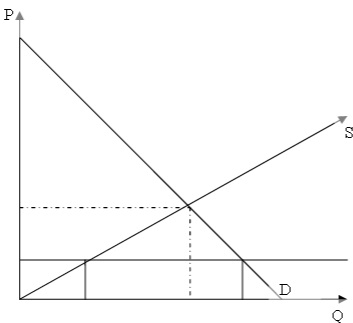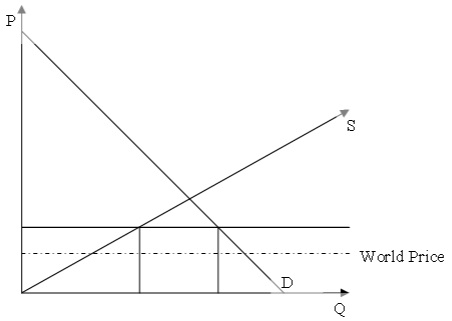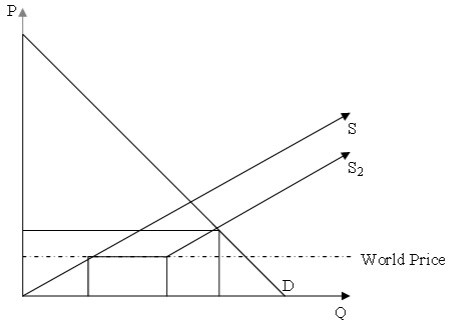Supply & Demand: Quotas and Tariffs
Exercise #1: Consider a closed economy with the following supply and demand equations for watches.
D: P = 50 – Q
S: Q = 3/2*P
a) Solve for the equilibrium quantity and price, consumer surplus, producer surplus, and total surplus and graph these below:

b) Now assume they open for trade, and the world price for watches is $10. Draw the effect this has on supply and demand above. Determine consumer, producer and total surpluses for this open econom y . Also determine the level of imports.
c) Now, there $5 tariff on im ports, raising the price to $15. Draw the effect this has on supply and demand below. Determ in e Qd, Qs, and the am ount im ported. Also determ ine consumer, producer and total surpluses, along with tariff revenue and deadweight loss.

d) Now, instead of a tariff, there is a quota, limiting watch imports to 12.5. Draw the effect this has on the supply and demand below. Determine Qd and Qs. Determine consumer, producer and total surpluses, along with quotarents and deadweight loss.

GDP: The total value of all final goods and services produced in the economy during a given year.
Exercise #2: What is/is not included in the calculation of US GDP?
- Money you spent at restaurants while touring Europe.
- The cost of Tax Services used in April.
- The cost of your newly purchased car.
- The cost of tires purchased by the car manufacturer to put on your new car.
- Purchase of your first house from a contractor.
- Purchase of your first house from the previous owner.
- Wages earned by illegal immigrants.
- Wages earned by US citizens while working in Canada.
- A woman living in New York spends a day cleaning her house, saving herself $100 doing it herself instead of hiring it out.
- An American businessman opens a plant in Japan that produces computers.
- Nick volunteers his time at the animal rescue shelter in Washington, DC.
- An American businessman produces computers in Idaho and sells these computers to consumers in Japan.
- List your own examples.
Exercise #3: The following table lists Nominal GDP, CPI, Real GDP and Population for a country.
Year Nominal GDP CPI(2000$) Real GDP Population Real GDP
per Capita
2006 $3600 120 3000 100
2007 $4410 126 3500 125
a) What was the growth rate for nominal GDP in 2007?
b) What was the growth rate for real GDP in 2007?
c) What was the inflation rate in 2007?
d) What was the growth rate of real GDP per capita?
e) What is the difference between Real GDP and Nominal GDP? What measure above represents an individuals’ average purchasing power?
Limitations of GDP measures (Pg 171 Krugman)
A. Based on aggregate output, better to use GDP per capita to compare countries
B. GDP per capita as a standard of living measure but it ignores distribution of income
C. Ignores black markets